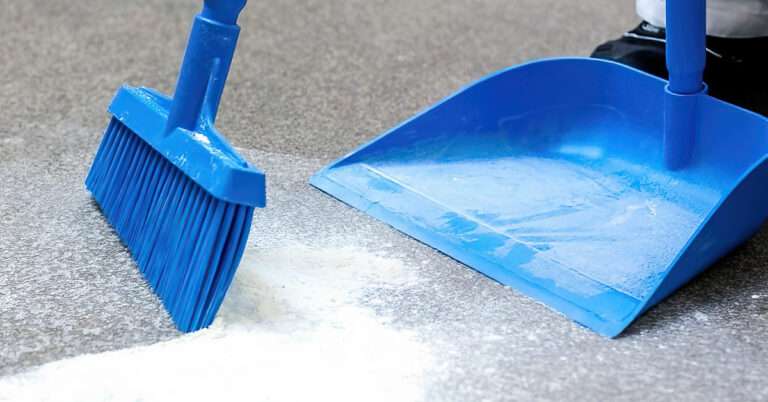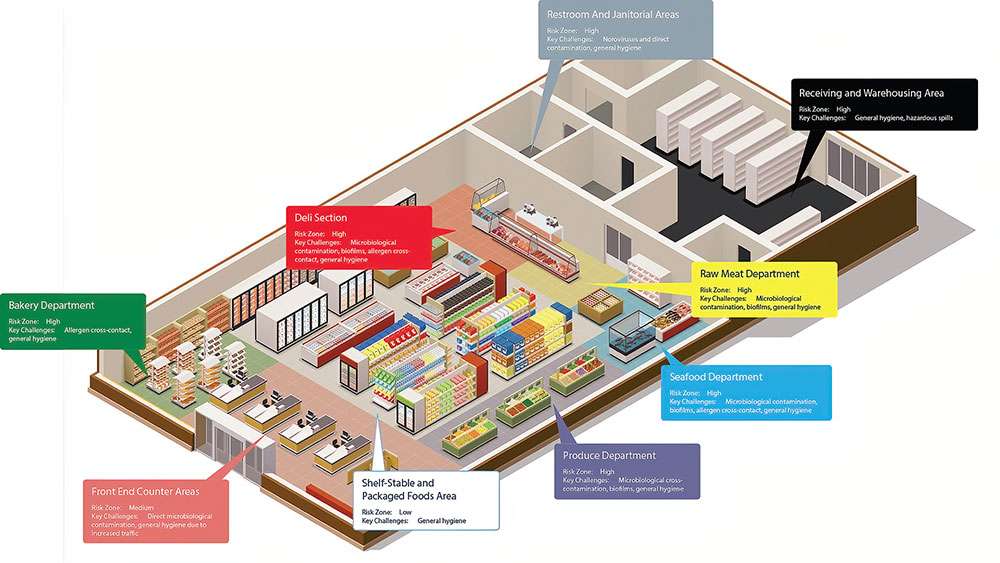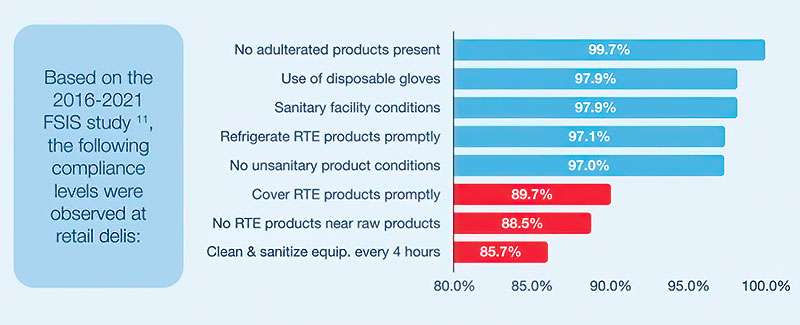
Avoiding food contamination incidents is a continuous challenge in food retail outlets like grocery stores and supermarkets. Proper cleaning and sanitation, hygiene, and material handling practices must be implemented to mitigate these risks. Equally as important, the selection, cleaning, storage, care, and maintenance of tools and equipment also need to be emphasized.
There is no one-size-fits-all solution for meeting sanitation challenges in food retail, and this post does not cover all the potential risks or strategies to combat them. However, we can help you assess your store’s risk and develop a plan.
Scope and Importance of the Food Retail Industry
The U.S. food retail industry, especially grocers with multiple store locations, account for market sales of $700-800 billion per year. Warehouse clubs and superstores make up 23% of the share.1 North American food retail businesses are of economic and food safety importance, mainly
because of the following reasons:
a) They are considered the last mile toward the consumer where anything could go wrong. For
instance, food might get contaminated during storage, handling, or transport.

b) They are a hub for assorted products (raw, prepared, temperature-sensitive, packed, etc.) and food safety related activities (ranging from handling of low-risk pre-packed products to preparing high-risk ready-to-eat meals).
c) The retail environment can pose safety risks to food, employees, and consumers and is prone to contamination, especially due to space limitations, traffic, and varying sanitation practices.
d) Sanitation practices are often subject to higher public scrutiny, especially during food preparation and handling. Consumers can complain about poor sanitation and hygiene, and retail inspectional violations are not uncommon.


Top Food Retail Industry Challenges – Regulations, Standards, and Certifications
There are many challenges to gaining a holistic view of the food retail industry’s regulatory
environment given the fragmented nature of those regulations. Here are some of the key points to
consider:
- Food retail establishments are regulated by different municipal, county, state, or tribal agencies depending on location.
- In most areas regulatory inspections are conducted annually, although some jurisdictions conduct more frequent inspections.
- Regulatory agencies may fully or partially adopt the FDA Food Code – this guidance document is a best practices model designed to help agencies develop or update their own food safety rules while staying consistent with national food regulatory policy.3
- Retailers may also participate in voluntary retailer standards programs that are benchmarked to GFSI Industry Scope H. The most common standard regimes include BRCGS Retail, SQF Code for Food Retail, FSSC 22000 for Wholesaling and Retailing, etc.
- Many jurisdictions require establishments preparing or handling “exposed food” to have at least one person go through food protection manager training and certification or its equivalent, and employees to have a valid food handler’s license. The ServSafe Certification (administered by National Restaurant Association) is one of the popular training choices for U.S. stores.

Top Food Retail Industry Challenges – Hygiene, Cleaning, and Sanitation
Hygiene, cleaning, and sanitation challenges pose a serious threat to food safety in retail outlets. The key food safety hazards found in food retail are similar to those encountered in food manufacturing facilities. These mainly include:
- Microorganisms of public health importance (Noroviruses, Listeria, Salmonella, E. coli, etc.)
- Microbial biofilms
- Allergen cross-contact
- Foreign material contamination
CDC foodborne illness monitoring data has consistently identified five major risk factors related to food safety practices within the retail food industry. Mitigating these risk factors can help reduce the hazards listed above. The CDC’s risk factors include:
- Poor personnel hygiene
- Food from unsafe sources
- Improper cooking temperatures and methods
- Improper time-and-temperature holding parameters
- Food contamination due to unclean facilities, equipment, or utensils
Employees and Food Safety
- Consistent and frequent food safety education and training programs build food safety culture.
- A full staff must be present during peak hours to ensure sanitation programs can be executed.
- Increased employee turnover further strains staffing levels, education, and training resources.
Consumer Trends and Food Safety
- Customers desire greater variety in the fresh foods they purchase, introducing more risk of microorganisms like Salmonella and E. coli.
- The rising demand for pre-cut, ready-to-cook foods, and prepared foods increases food retail risks. For instance, according to a recent industry report, in-store dining and prepared food take-out from grocers have grown nearly 30% since 2008.
- A greater variety of fresh and prepared foods at stores requires more utensils, storage, and tracking, which further complicates sanitation and hygiene practices.

Basic Strategies for Addressing Food Safety Challenges – Dos and Don’ts
These top-level tips will help jumpstart sanitation practices. This is not a comprehensive list of best practices, but these examples are critical elements of a broader food safety plan.
DO
- Wash hands properly before handling food.
- Train employees on food safety standards.
- Segregate tools used in different hygienic and environmental monitoring zones.
- Follow Good Retail Practices at all levels, from receiving, handling, storage, and dispatch.
- Identify, separate, and protect food from contamination from key hazards.
- Clean and sanitize food contact surfaces and utensils.
- Use tools that effectively clean while minimizing the spread of contaminants.
- Identify and separate allergen-containing ingredients that may influence food safety.
- Apply an integrated sanitation approach that helps keep food safe under sanitary conditions.

DON’T
- Use bare hands when handling exposed food.
- Work when you are ill or have exposed sores on your skin.
- Use the same tools and resources for both raw and ready-to-eat product zones.
- Ignore post-processing contamination possibilities.
- Disregard cleaning non-food contact surfaces even if they don’t impact food directly.
- Underestimate the danger of improperly stored wiping cloths in spreading contaminants.
- Use floor tools on counters or other food contact surfaces, and vice-versa.
- Forget to label allergen-based ingredients clearly during food preparation.
- Rely only on cleaning and sanitizing surfaces, since other programs like hygienic zoning, hygienic design, etc., also matter.

Contamination Prevention
When developing food safety strategies, it’s important to consider four key factors: products, processes, places, and people. Only a few common strategies have been provided for each factor:
(A) PRODUCTS:
- Exposed perishables such as meat, fruits, and vegetables can harbor pathogens that may develop into persistent biofilms. More cleaning and sanitation efforts are required for food storage and handling areas.
- Allergen-containing products that may spill or spread need to be controlled. Color coding can be used to identify allergen handling or cleaning tools to avoid accidental cross-contact.
- Prepackaged products generally in low-risk areas are less prone to cross-contamination. However, hygiene still needs to be maintained in such areas so as to not attract dirt and pests.
(B) PROCESSES:
- Where temperatures within the danger zone (40° F to 140° F) are encountered, or where production processes introduce moisture, conditions are favorable for pathogen growth. Such areas require frequent in-between cleaning, at least after every 4 hours.
- Recommend high-temperature tools for cleaning heated ovens, as well as abrasive-resistant and chemical-resistant tools for cleaning drains.
(C) PLACES:
- The environmental surfaces, whether food contact or non-food contact, need to be accessible, inspectable, and cleanable without spreading contamination. This requires appropriate sanitation tools and aids.
- At high-risk zones, there may be a higher inventory turnover of tools; more hygienically designed tools may be required; more specialized tools for deep cleaning may be used; a detailed focus on nooks and crannies is standard; and cleaning frequency may be intensified.
(D) PEOPLE:
- A high level of personnel hygiene, cleaning, and sanitation standard is required where exposed, temperature-sensitive, or ready-to-eat foods are handled.
- Areas where there are more people flowing through or employees handling food need to be cleaned frequently.
Understanding Risk by Grocery Departments
The different grocery departments may be classified by hygienic zones, which can be:
• High Risk: Strictest sanitation and hygiene requirements; regular cleaning and monitoring.
• Medium Risk: Less strict requirements than high risk; periodic cleaning and monitoring.
• Low Risk: Lower sanitation/hygiene requirements; less frequent cleaning and monitoring.
Cross-over of ingredients, equipment, tools, utensils, and people between different hygienic zones may lead to food contamination incidences, which may be avoided using a properly color-coded hygienic zoning plan.
Please Note:
At high-risk zones, there may be a higher inventory turnover of tools; more hygienically designed tools may be required; more specialized tools for deep cleaning may be used; detail cleaning may be required; and cleaning frequency may be
intensified.


Food Retail Department Strategy – Focus on the Deli
We can safely call this the riskiest of the departments as historically, foodborne illness outbreaks have been associated with retail deli establishments. Pathogens of public health importance are:

At retail delis, cleaning and sanitation must be taken seriously – here food-contact surfaces must be cleaned, sanitized, and routinely inspected:
- Before and after every use, and
- At least after every 4 hours to prevent cross-contamination incidents.

Did you know? According to a recent CDC study, 9.4% of U.S. delis sampled had potential cross-contamination among raw meats and ready-to-eat foods during preparation. Also, in 24.6% of the delis with a cold storage unit, raw meats were not stored separately from ready-to-eat products.
The FSIS Guidance for Controlling Listeria monocytogenes (Lm) in Retail Delicatessens 10 provides key best practice tips for deli operators. Among other controls, cleaning and sanitizing requirements mentioned in the guide are as follows:
- Develop written sanitation procedures that describe how utensils and equipment (e.g., slicers) must be cleaned and sanitized prior to use.
- Clean and sanitize utensils and equipment used to handle, prepare, and store RTE products frequently (at minimum every 4 hours).
- Disassemble RTE food-processing equipment when cleaning and sanitizing to ensure that hard to reach areas where Lm can hide are addressed.
- Scrub surfaces during cleaning to prevent biofilms from forming.
- Follow the manufacturer’s recommendations for sanitizer strength and application, including exposure time, to ensure it is effective.
- Consider rotating sanitizers to provide more effective bacterial control.
- Develop a procedure to sanitize cleaning aids (such as cloths and scrub brushes) or have single-use items that are discarded after use.
- Use low water pressure when cleaning in the deli areas to minimize splashing and overspray.
- Use separate sinks for hand washing and cleaning product or equipment.
- Eliminate or remove unnecessary items (e.g., supplies and equipment) from the deli area.


Making a Contamination Prevention Plan
A step-by-step approach generally involves:
a) Identify the hazards or sanitation challenges:
This may include risk-based evaluation of microbial contamination, biofilms, allergens, hygiene issues, etc.
b) Determine how to mitigate risks:
Find out if GMPs are sufficient or whether additional process, allergen, sanitation, supplier or other critical controls are required to manage the hazards.
c) Decide on the sanitation tools:
Tool selection, care, and maintenance is crucial. Refer to the next section.
d) Allocate responsibilities:
Clearly define the roles of food handlers, sanitation crew, management verifiers, or reviewers in assuring food safety and sanitation at the store.
e) Communicate the plan:
Educate, train, and regularly refresh concerned people on key food safety and sanitation tasks and responsibilities.
Tool Selection, Care, and Maintenance
Proper selection, use, cleaning, storage, maintenance, and replacement of tools can prevent contamination incidents, whether they are microbiological or foreign material cross-contamination, allergen cross-contact, or direct contamination incidents caused by employees.
 Tools can become potential vectors of contaminants if not cleaned and sanitized before and after use. According to a 1990 U.K. Study, 47% of the cleaning equipment sampled in a food production facility was found positive for Listeria monocytogenes.
Tools can become potential vectors of contaminants if not cleaned and sanitized before and after use. According to a 1990 U.K. Study, 47% of the cleaning equipment sampled in a food production facility was found positive for Listeria monocytogenes.
To minimize the risks of cross-contamination, the cleaned tools should be stored properly on racks or shadow boards:
- With heads down and off the floor with enough distance from other tools so they don’t spread contaminants among them;
- In a single row so that condensate from tool above does not drip onto the tool below; and
- Only after they’ve been regularly cleaned and sanitized, as appropriate.
The following are more tips and guidelines on tools:
- Select the right kind of tool for the job – e.g., the right brush or broom bristle type or squeegee blade size and type. Insist on food-safe, durable, total color, hygienically designed tools for use in high-risk areas of the food retail establishment.
- Where high temperature-resistant tools or chemical-resistant tools are required, mandate that purchasers must check if the tool meets the operation’s requirements.
- Don’t allow tools to be taken from one hygiene zone into another. Identify via color coding.
- Advise workers to not to mix food contact tools with non-food contact tools (e.g., those used on drains). Have separate storage stations and color designations.
- Clean and sanitize tools, as appropriate. Tools can be vectors of contaminants.
- Encourage workers to regularly inspect tools for damage, wear, and tear, and replace them as appropriate, based on risk assessment. Do not use a worn-out tool in a high-risk environment.

How Remco Helps Retail Industry Clients
Remco can recommend appropriate sanitation solutions for food retail establishments, such as:
- selecting the right kind of food-safe, durable, and hygienically designed tools, as well as appropriate cleaning, storage, and maintenance solutions.
- implementing a color-coded hygienic zoning plan.
- providing cleaning and sanitation tips for food-contact and non-food-contact surfaces.
- providing tools and garments that support employee hygienic practices.
They also have a comprehensive knowledge center, and the following white papers are most useful for food retail establishments.
- Color-Coding to Improve Food Safety
- Cleaning Tool Maintenance
- Hygienic Design of Food Industry Brushware
- 5S in the Food Industry
- The Role of Manual Cleaning in Biofilm Prevention and Removal
For more information, visit their website, remcoproducts.com, contact them at cs@remcoproducts.com, or schedule a site visit with one of their business development managers.

Additional Information
As an update to the recent developments in U.S. Food Retail, the FDA has been working on a blueprint on the “New Era of Smarter Food Safety.” Of emphasis, is Core Element #3 on the “New Business Models and Retail Modernization.” In response, the U.S. regulators and partners have come together to form the Retail Food Safety Regulatory Association Collaborative as a forum for working together in helping to reduce foodborne illnesses linked to the retail sector. More information is available at: https://www.retailfoodsafetycollaborative.org/.
References
- U.S. food retail industry – statistics & facts | Statista
- Foodborne Illness Outbreaks at Retail Establishments — National Environmental Assessment Reporting System, 16 State and Local Health Departments, 2014–2016 | MMWR (cdc.gov)
- FDA Food Code | FDA
- ServSafe® – ServSafe Food Handler
- Foodborne Illness Risk Factors (washoecounty.us)
- Nov-Dec-13-Rowell.pdf (foodprotection.org)
- Grocerants: How Grocery Stores Have Taken on Restaurant Food Safety Challenges – Corvium
- More fresh food means more food safety headaches (supermarketnews.com)
- Meghan M. Holst, Laura G. Brown, Brendalee Viveiros, Brenda W. Fav, Nicole Hedeen, Wendy McKelvey, David Nicholas, Danny Ripley, Susan R. Hammons; Observed Potential Cross-Contamination in Retail Delicatessens. J Food Prot 1 June 2021; 84 (6): 1055–1059.
- Guidance for Controlling Listeria monocytogenes (Lm) in Retail Delicatessens – Best Practice Tips for Deli Operators | Food Safety and Inspection Service (usda.gov)
- Conference for Food Protection (August 2021). FSIS Policy Updates: Percentage of Delis Following Each of the Top 8 Recommendations (FY16Q2 – FY21Q3).
- How to Keep Cleaning Tools from Becoming Vectors of Contamination | Your Partners in Hygiene (remcoproducts.com)

